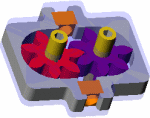 |
|
 |
2.972 Understanding How Things Work |
|||||||||||||||||||||||||
| Instructor:
Martin Culpepper Phone: 617 - 258 - 8541 E-mail: mculpepp@mit.edu |
Room: 35-125A Time: 9am -12.00 then 1.30 - 4pm Credit: P/D/F Units: 6 Units |
||||||||||||||||||||||||
| Grading: Grading
[75% = pass] -35% Final Report -20% Class Participation/Field
Trips -25% Labs -20% External Gear Pump/Motor Project |
|||||||||||||||||||||||||
| Session 1: Jan. 4 - 15 M, T, W, R, F (FINIS!) | Session 2: Jan. 19-29 M, T, W, R, F | ||||||||||||||||||||||||
| Understanding How Things Work is About: Learning how some mechanical, hydraulic, and electro-mechanical devices operate. In lab, you will (in groups) disassemble several machines, then model the operation of each device. Devices which are of particular interest to students, or impractical to disassemble in lab will be examined during field trips and through final reports. Some of the skills/knowledge you will acquire in 2.972 are:
|
|||||||||||||||||||||||||
| Day | Work Shop Lecture [mandatory] |
Workshop Hands On [mandatory] |
Lab [mandatory] |
| 1 Tuesday |
Lecture:
» Discuss Course
» Questionnaire
» Discuss prizes
» Functional Requirements
& Design Parameters
» Understanding Geometry, Structure,
Physics, and Flow
» Sketching Basics
» Conversion Spread Sheet
Tour:
» Waterjet and "Take Apart" Lab (9.45 am)
Assignment: To Read/Research:
» Lab write ups, final reports, sample report
» Solid Modeling Introduction (under design tools)
» Spread Sheets (under design tools)
» Final projects via web, patents, library
|
Workshop 1 Understanding: 1. Spread Sheets: |
GO TO LIBRARY AND RESEARCH FINAL REPORTS |
| 2 Wednesday |
Lecture: » Basic Physics » Limiting and Dominant Physics » Understanding magnitudes (power, torque, force, size) » Sketching Assignment:
Solid Modeling tutorial |
Workshop
2 Sketching Exercise & Solid Modeling Tutorial These are important, because: 1. Physics & Flow: |
Lab #1 |
| 3 Thursday |
Lecture: » Basic Manufacturing Processes » BASIC GEAR PUMP DESIGN Assignment: Solid Modeling tutorial |
Workshop
3 Solid Modeling Cont. & External Gear Pumps By the end of the day you should have: |
Lab #1 cont. |
| 4 Friday |
Lecture » Solid Modeling & Design Intent Assignment » Work on Gear Pump Design and Solid Model Tour: » MIT MEMS Lab (2.00 PM) |
Workshop
4 Begin Solid Modeling of Gear Pump By the end of the day you should have: |
Lab #2 |
| Weekend |
I will be available in 35-125A on Saturday and Sunday from 11 am to 5pm. |
You should finish designing your PUMPS | |
| 5 Monday |
Lecture: None! Assignment: » Finish Gear Pump CAD Model Tour: » MIT Physical Plant (1.30 PM) |
Workshop 5 Finish Design of Gear Pump By the end of the day you should have: |
Lab #2 cont. |
| 6 Tuesday |
Lecture: Basic HTML
and using Microsoft Word to make web pages
|
Workshop
6 Make Gear Pump Prints, Correct Reports, and Convert Reports to HTML HTML is important because you will: 1. Need to write your final
report as web pages. We will collate our reports and make the base pages of the MIT's
How Things Work Web Site. By the end of
the day you should have: |
Lab #3 |
| 7 Wednesday |
Lecture: None
|
Workshop 7 By the end of the day
you should have: |
Lab #3 cont. |
| 8 Thursday |
Lecture: None Assignment: » Make final corrections to final report » Finish CAD models/sketches for your report » Go to lab and take apart stuff if you are finished! Tour: » Car Wash (~3.15 PM depending upon interest & time) |
Workshop 8 By the end of the day
you should have: |
Lab #4 |
| 9 Friday |
Lecture: » Review Class » Suggestions Assignment: » Assemble gear pumps/motors » Get ready for pump/motor contest!!! » Make finishing touches on reports » Hand in reports |
Workshop
9 Hand in Report, Build Pump, Have Contest By the end of the day you should: |
Lab
#4 cont. |